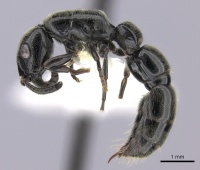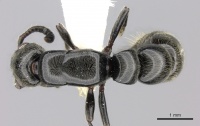Simopone dignita
| Simopone dignita | |
|---|---|
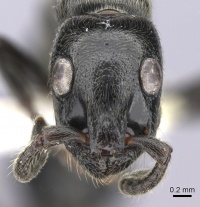
| |
| Scientific classification | |
| Kingdom: | Animalia |
| Phylum: | Arthropoda |
| Class: | Insecta |
| Order: | Hymenoptera |
| Family: | Formicidae |
| Subfamily: | Dorylinae |
| Genus: | Simopone |
| Species group: | emeryi |
| Species: | S. dignita |
| Binomial name | |
| Simopone dignita Bolton & Fisher, 2012 | |
The type material was found in a dead branch above the ground in tropical dry forest.
Identification
A member of the emeryi species group. Simopone trita and S. dignita form a small complex of species that in Madagascar is morphologically intermediate between the silens and emeryi complexes. They combine the reduced pilosity of the latter with the stocky AIII and posteriorly shifted eyes of the former. The two species are easily differentiated by the characters noted in the key but in addition the posterior margins of tergites AIII and AIV in trita have a few short setae at most, whereas in dignita these margins each have a fringe of distinct setae that are obviously curved towards the midline. (Bolton and Fisher 2012)
Keys including this Species
Distribution
Latitudinal Distribution Pattern
Latitudinal Range: -16.36833333° to -16.36833333°.
| North Temperate |
North Subtropical |
Tropical | South Subtropical |
South Temperate |
- Source: AntMaps
Distribution based on Regional Taxon Lists
Malagasy Region: Madagascar (type locality).
Distribution based on AntMaps
Distribution based on AntWeb specimens
Check data from AntWeb
Countries Occupied
| Number of countries occupied by this species based on AntWiki Regional Taxon Lists. In general, fewer countries occupied indicates a narrower range, while more countries indicates a more widespread species. |

|
Estimated Abundance
| Relative abundance based on number of AntMaps records per species (this species within the purple bar). Fewer records (to the left) indicates a less abundant/encountered species while more records (to the right) indicates more abundant/encountered species. |

|
Biology
|
Castes
Worker
Images from AntWeb
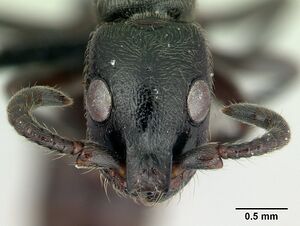 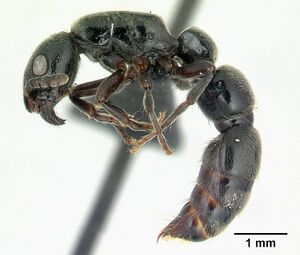 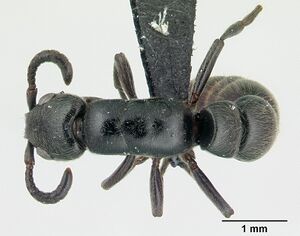 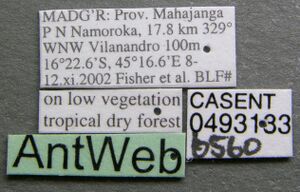
| |
| Worker. Specimen code casent0493183. Photographer Erin Prado, uploaded by California Academy of Sciences. | Owned by CAS, San Francisco, CA, USA. |
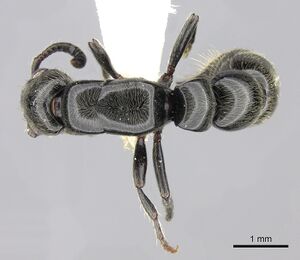
| |
| Holotype of Simopone dignita. Worker. Specimen code casent0009816. Photographer Shannon Hartman, uploaded by California Academy of Sciences. | Owned by CAS, San Francisco, CA, USA. |
Nomenclature
The following information is derived from Barry Bolton's Online Catalogue of the Ants of the World.
- dignita. Simopone dignita Bolton & Fisher, 2012: 45, figs. 37-39 (w.) MADAGASCAR.
- Type-material: holotype worker, 9 paratype workers.
- Type-locality: holotype Madagascar: Prov. Mahajanga, PN Namoroka, 17.8 km. 329° WNW Vilanandra, 100 m., 16°22.6’S, 45°16.6’E, 8-12.xi.2002, BLF6561, CASENT0009816, ex dead branch above ground, tropical dry forest (B.L. Fisher); paratypes: 3 workers with same data, but CASENT0489939, 3 workers with same data, but CASENT0489940, 3 workers with same data, but CASENT0489941.
- Type-depository: CASC.
- Distribution: Madagascar.
Unless otherwise noted the text for the remainder of this section is reported from the publication that includes the original description.
Description
Worker
(holotype in parentheses). HL 1.44–1.82 (1.60), HW 1.00–1.34 (1.18), SL 0.40–0.57 (0.50), EL 0.39–0.48 (0.44), PW 0.80–1.11 (0.99), AIIW 0.80–1.06 (0.97), AIIL 0.76–0.92 (0.85), AIIIW 0.91–1.26 (1.09), AIIIL 0.90–1.16 (1.02), WL 1.58–2.16 (1.92), MFL 0.80–1.18 (1.02), CI 69–74 (74), SI 39–43 (42), EL/HW 0.35–0.39 (0.37), EP 1.10–1.24 (1.24), AIIW/AIIL 1.05–1.16 (1.14), AIIIW/AIIIL 1.01–1.17 (1.07) (8 measured).
In full-face view anteriormost points of frontal lobes are about level with the midpoint of the shallowly convex to transverse anterior clypeal margin. Eyes located behind the cephalic midlength (EP 1.10–1.24). Leading edge of scape with at least one projecting seta that is curved or inclined toward the scape apex. In full-face view sides of head in front of eyes usually without projecting short setae, but one or two may occur; behind eyes only with minute pubescence that is appressed or very nearly so. In profile frontal carinae with relatively long setae and cephalic dorsum with 2–3 standing short setae above the eye, and usually also with a very few decumbent setae that are located more posteriorly. Cephalic dorsum between eyes densely but shallowly punctate, the punctures adjacent or nearly so. Anterior and dorsal surfaces of pronotum separated by an angle or weak margination, but without a strongly defined carina. Propodeal dorsum meets declivity through a blunt angle, without a transverse carina. Promesonotal suture weakly impressed; metanotal groove vestigial to absent. Mesosoma in dorsal view not distinctly constricted at the mesonotum; mesosoma narrowest across pronotum, mesonotum the same width or fractionally broader, broadest across propodeum (in holotype PW 0.99, maximum width across mesonotum 1.00, maximum width across propodeum 1.06). Dorsum of mesosoma densely finely punctate everywhere. Mesosoma with a short seta close to the pronotal humeri (very easily abraded away); mesosoma otherwise without setae but entire dorsum with appressed pubescence. Dorsal (outer) surfaces of mesotibiae and metatibiae mostly with a projecting seta present close to their apices; often with another close to the midlength. Dorsal surface of AII (petiole) meets anterior surface in a narrowly rounded angle, without a transverse carina. Posteriorly the dorsum of AII lacks a sharp carina but a weak ridge is present above the foramen. In dorsal view the posterior corners of AII are extended into small but stout triangular teeth that project posterolaterally. Lateral surface of AII, below the dorsolateral margin and above the level of the spiracle, without a longitudinal ridge or carina that extends the length of the sclerite. In dorsal view AII and AIII distinctly broader than long; AIV also broader than long. Abdominal tergite AII at most with one or two setae posteriorly, but AIII and AIV each with a fringe of setae along the extreme apical margin; the setae curved towards the midline and the central ones crossing over. All three tergites also with greyish appressed pubescence. Setae distinct on sternites of AIII and AIV. Abdominal tergites AII to AIV sculptured only with small punctures. Full adult colour black, appendages blackish brown to black; clypeus usually slightly lighter in shade than remainder of head capsule.
Type Material
Holotype worker, Madagascar: Prov. Mahajanga, PN Namoroka, 17.8 km 329° WNW Vilanandro, 100 m, 16°22.6’S, 45°16.6’E, 8-12.xi.2002, BLF6561, CASENT0009816, ex dead branch above ground, tropical dry forest (B.L. Fisher) (California Academy of Sciences). Paratypes. 3 workers with same data as holotype but CASENT0489939; 3 workers with same data but CASENT0489940 (bottom worker on pin with AII to apex detached and mounted separately); 3 workers with same data but CASENT0489941 (CASC).
References
- Bolton, B. & Fisher, B.L. 2012. Taxonomy of the cerapachyine ant genera Simopone Forel, Vicinopone gen. n. and Tanipone gen. n. (Hymenoptera: Formicidae). Zootaxa 3283, 1–101 (doi:10.11646/zootaxa.3283.1.1).
References based on Global Ant Biodiversity Informatics
- Bolton B., and B. L. Fisher. 2012. Taxonomy of the cerapachyine ant genera Simopone Forel, Vicinopone gen. n. and Tanipone gen. n. (Hymenoptera: Formicidae). Zootaxa 3283: 1-101.
